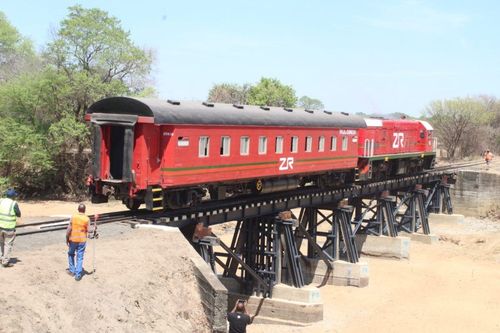By Pamela Kapekele in Livingstone
Despite being a crucial link and a lifeline for numerous communities spanning from Livingstone to Mulobezi district, the Mulobezi railway line remains in a state of neglect, over 50 years since Zambia Railways assumed control from private owners.
Extending across 162 kilometres, connecting the tourist hub of Livingstone to the remote Mulobezi district, this railway line, weathered by time and abandonment, serves a role beyond mere transportation.
Its importance goes beyond the rusted tracks, functioning as the sole dependable water source for communities in drought-prone regions and acting as a vital connection between two districts isolated by geographical challenges.
MakanDay traced the route from Livingstone through Kazungula, aiming to witness firsthand the deteriorating state of the railway line. Here, the interplay of rust and decay intertwines with the hopes and aspirations of a community heavily reliant on its continued existence.
Complex web of challenges
In this exploration, a MakanDay journalist explores the complex web of challenges that have brought this vital lifeline to the brink, endangering not only the connection between Livingstone and Mulobezi but also the flow of sustenance to drought-stricken regions.
As Pamela pursued this weathered railway, narratives of both desperation and resilience unfolded. These tracks carry more than just passengers; they also transport water to arid lands. This once-vital railway line, conceived in an era when progress was measured in steam and iron, now grapples for survival, echoing the struggles of the communities it once served with unwavering dedication.
Her journey commenced at Livingstone’s Dambwa Central Market, where the steel railway sleepers bore signs of wear. On foot, she followed the path through the former Zambezi Sawmills tiny staff houses, now juxtaposed against a sprawling unplanned settlement. The railway line then traversed the Mosi-oa-Tunya National Park, a restricted area that she was unable to traverse without permission. Retracing her steps, she returned to the Nakatindi road, where a vehicle awaited her next phase of exploration.
She encounters the Mulobezirailway line again near Simonga on the Livingstone-Sesheke Road, and the situation becomes even more disheartening. The sleepers appear increasingly damaged as the line extends further from Livingstone.
Monde Munalula, a local resident from Chief Sekute’s area, joins her out of curiosity. After explaining her mission, he shares valuable information.
“I have traveled on the train many times. It moves very slowly due to the dilapidated railway line,” he explains. “The train always carries a team of men to repair the line as they progress. Sometimes it can come to a complete halt for a day, allowing the team to mend sections of the line. Without these repairs, the train wouldn’t be able to move. Many lives would have been lost if not for these essential repairs.”

Munalula guides her to a section of the railway line that is scarcely visible, partially buried in sand with shrubs sprouting around. This may be due to the train’s suspension during her visit in October, leading to inactivity. However, Munalula notes that this scenario is not uncommon even when the train is operational.
He explains that villagers sometimes get involved by placing plastics on poles along the line to alert train drivers to the worst sections, where shrubs have overgrown or sleepers are damaged or vandalized.
As the teams inspects the steel sleepers, the year 1927 catches their attention, likely marking the year they were initially laid down—almost a century ago.
Siambizi, the accident site
Moving on to Makunka, a village bearing the brunt of severe wear and tear on the railway line, locals inform the team that they are approaching Siambizi, the site of a derailment accident in December 2021.
Navigating the line by road becomes challenging at this juncture. The team is directed to a road on the eastern side of Kazungula, which, they are told, eventually reconnects with the railway line.
They lose the way and find themselves in a place called Nguba, a true wilderness with scattered villages, or so they initially thought.
Stumbling upon a ramshackle structure housing around 30 women, it appears to be a traditional grass-thatched kitchen of some sort.
Several women are busy preparing assorted meals, and the team soon discover that the building serves as a mother’s shelter for relatives of women admitted to the nearby Nguba Clinic.

Insights from the District Commissioner
A conversation with Elias Siambila, the District Commissioner for Kazungula, provides insights into the challenges facing the railway line and its impact on the community. Siambila informs them that Nguba is actually one of the densely populated wards in his district.
He shares that Nguba Clinic was constructed using the Constituency Development Fund (CDF) in 2012. Siambila explains that communities in Nguba Ward used to trek about 50 to 60 kilometres to access health services at a place called Kaume.
The local authority noticed numerous challenges in child deliveries, leading to the establishment of the clinic to address these issues
“Through the CDF, everything was provided, including staff houses,”Siambila remarked. “The district director of health even registered the clinic to access drugs from Zambia Medicine and Medical Supplies Agency’s monthly allocation. Within six months, the clinic recorded 226 births. And now, the Government is set to provide a maternity annex from the 2023 CDF.”
When inquiring about the mother’s shelter lacking visible sanitation facilities, Siambila clarified that the shelter was a temporary structure built by community members. He assured the team that the council would soon construct a better shelter. Additionally, he mentioned that the women were able to obtain water from a nearby school, which also served the clinic.

Siambila’s thoughts about the railway line
Siambila also shared his thoughts on the railway line, describing it as having exceeded its lifespan.
“I am grateful that the Government has commissioned the Bombwe Bridge, and we are now able to use the Mulobezi train,” Siambila said. “Civil servants on the Mulobezi route do all their shopping in Livingstone, and traders rely on it as well. You can imagine just how crucial the train is for them. While it’s positive that the train has been refurbished, the railway line itself has outlived its lifespan. We should have replaced it after 30 years, but it is now over 100 years old.
“We have the opportunity to transform the Mulobezi train into one of the best, complete with proper sleepers. Currently, the journey from Livingstone to Mulobezi takes five days, which is unjust,” Siambila expressed. According to him, with proper improvements to the railway line, the train could cover the distance in just four hours.
“That train could be highly efficient, especially if the government constructs a gravel road alongside the railway line,” he suggested. “Consider the challenges the sick and elderly face now. Boarding the train comes with concerns about potential derailment. In my opinion, political will can revitalize the entire system.”
Kazungula hosts the longest stretch of the Mulobezi railway, making it one of Zambia’s largest district at 19,000 square kilometres.
Siambila confirmed that the district faces water scarcity, and some boreholes drilled in the past yielded salty water. This issue arises from the district being part of the salt domes that extend into Botswana’s salt mining area. Areas affected by salty water include Sikaunzu, Kasawa, Mapani, Mambova, Mandiya, Katombora (near the Zambezi River), and other regions where the salt domes stretch.
Siambila mentioned that salt is also responsible for houses cracking in Kazungula.
“We even need to consider mining that salt,” he stated. “In some areas, salt is found on plainland. The University of Zambia is currently studying the extent of salt deposits in Kazungula.”
He admitted being aware of communities that draw water from the Mulobezi train.
“I am aware that the Mulobezi Train makes a stop at Kalamba (Chief Moomba’s area) to draw water from the borehole there,” he shared.
“This water source is primarily for those on the train.” He revealed that nearly all the dams in the district had dried up, emphasising that USAID had committed to sinking 80 boreholes by April of this year to address the water scarcity issue. He also mentioned that constructing more dams would provide a long-term water solution, indicating that the District Water Engineer had secured funding for dam surveillance.
When their conversation concluded, they resumed their journey to locate the next segment of the railway line. They found it near Bombwe, with assistance from locals guiding them to the actively worked-on Bombwe Bridge by Zambia Railways.
Last year, the Government allocated K27 million to Zambia Railways for the rehabilitation of the railway line, particularly focusing on the Bombwe Bridge. The team decided that Bombwe would be their final stop, and they headed back to Livingstone.
As they returned, it became evident that the railway line, once a symbol of progress, now stands at the crossroads of neglect and potential revitalisation. The destiny of this lifeline, intricately linked with the fate of the communities it serves, depends on addressing its structural deficiencies urgently and the commitment of those with the power to bring about change.
Zambia Railways remains silent on the issue. Notably, certain aspects of the ongoing works, such as the reinforcement of the 100-year-oldtimber on Bombwe Bridge with steel as a temporary measure, prompted a press inquiry directed to Zambia Railways’ public relations unit.
Sombe Longwani, the Public Relations Manager, sought additional time to thoroughly assess the report submitted by the engineers overseeing the bridge project, citing its technical intricacies. As of press time, however, she had not yet transmitted the document.

Discover more from MAKANDAY
Subscribe to get the latest posts sent to your email.



